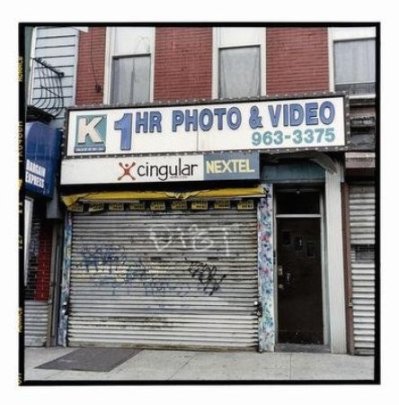I had high hopes for “Analogue”, Zoe Leonard’s 10-year plus project now on view at The Museum of Modern Art. All artists of my generation, including myself, are affected by and respond differently to this overwhelming datascape we have at our disposal. Leonard’s approach is archival though not nostalgic and without a directive moral. She begins her investigation, over ten years ago, in her quotidian surroundings and traces them to where they reach beyond her immediate environs. The data is presented in the form of photographs that record either a storefront that used to exist in her Lower East Side neighborhood or a market place, somewhere far away, where the goods from the former store have been relocated for sale. Leonard archives and collects data, which gathers critical distance and mass over the time. The work brings to mind Berndt and Hilla Becher’s work, both in its documentary form and its focus on the architecture of the place, and format, square photographs arranged in grids.

The show, installed in MoMA’s atrium, is comprised of 412 photos, each square in format and held with clean L clips, arranged in various square or rectangular grids, like chapters, forming a non-regular but clean looking order. The differences in sizes of grids, rows and columns allows for fluidity and visual variation, while the uniform spacing between individual images maintains visual rigor. MoMA’s atrium is a space that has so much flux going on it can be hard for artworks to hold focus. The installation itself, the curatorial work of Roxana Marcoci and her photography department in collaboration with the artist, is beautiful; it is pared down but not too spare, and it makes a powerful impression. Both the installation and the work are strong, disciplined and serious, the installation in service to the work, demanding respect. My only complaint in viewing the pieces is that there is glare on some of the photos, making it hard to examine the works individually – too bad because the individual elements in the photos are a crucial layer of the work and the project’s attempt to follow the pieces globally.

The work itself begins by tracking a largely gone, fabric-based sales area of the Lower East Side, Leonard’s own neighborhood and path of daily routine. Having lived and worked in the East Village and Lower East Side for a long time, the photographs were of interest to me in part because I wanted to identify the former locations. But they hold interest beyond my own curiosity. They are straight-on, honest and plain images, documentary in form, owing to Walker Evans’ legacy among others, that allow the viewer to sample the data on view without bias of unusual camera angle or sentiment (aside from some nostalgia that cannot help but be perceived as with anything lost or bygone). The images of these storefronts and their consistency of view is exacting as they document no longer existing specimens from the Lower East Side.


The work continues past the storefronts to track the goods once sold inside the Lower East Side establishments and now part of a global storefront. While I appreciate the conceptual tracking of goods, the artist’s investigation, and her desire to trace our globally fragmented world in which goods are endlessly moved about, the work loses some of its rigor when it tries to take on the varying architectures of the myriad places where the goods have travelled to. I wish she had applied a colder, tighter and more architecturally focused frame to the marketplaces as she did to the storefronts. The images of the storefronts are consistently framed, giving equal value to each, and no preference of a deli over a fabric store for example. However, once Leonard follows the goods from these storefronts, the frame is, inevitably lost, as markets and shipping yards cannot necessarily be captured from equal distances, angles, lines of entry. As a result, the roughly second half of the show holds less power than the first half. I wish the artist could have maintained a similar meticulousness to the framing of the marketplaces, whether shooting individual stalls within a larger market or some other constraint that allowed these images to be more formally consistent. Much of the appeal of the storefronts is their laboratory-like examination. Once the documentation leaves the Lower East Side, so too does the feeling of examining specimens or data.


Some of this may have to do with editing. Leonard’s photos number somewhere beyond 10,000. The task of editing this to 412 is immense – just the ability to layout the images to view at once – affects how the viewer interprets it. Still, there is a responsibility for the artist or the curator/exhibitor to deal with the plethora of visual data, especially in our contemporary visual culture of image saturation. The selection process and what is selected becomes a major part of the artwork. The conceptual strength of the project carries through, and the idea that Leonard followed her initial storefront photographs across the world as a means of tracking gentrification and globalization is valid and more than worthy of pause. But, I cannot help feeling that the work takes on a nostalgia or a potential bias that detracts from the message of global goods, once the persistent frame is lost.
On view at the Museum of Modern Art June 25–August 30, 2015
Written by Katherine Keltner, Contributing Writer to POVarts

